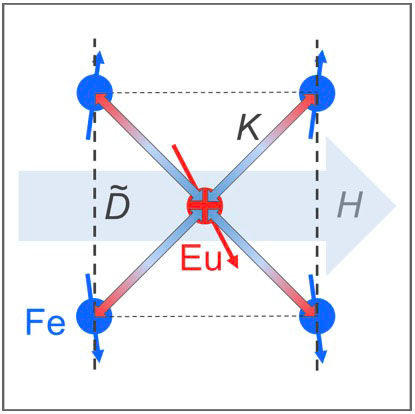Structure of a metal-organic material with applications in the fields of health care and communications determined
A study with the participation of CSIC shows that copper escuarate contains large empty channels of high porosity
A research team with the participation of the Spanish National Research Council (CSIC) has determined the crystalline structure of copper squarate, a metal-organic material. The scientists have discovered that, as in other materials of this type, it contains large empty channels that give it great porosity and, together with its structural uniformity, make it suitable for use, for example, in the absorption of polluting gases and chemical compounds. The study is published in Solids.

Three-dimensional image of a channel in the crystal structure of copper escuarate.
CSIC
"By knowing the structure of copper escuarate we have been able to study its compressibility and see that the material has negative linear compressibility (NLC), a property that has multiple potential applications since materials of this type, strange as it may seem, compress when stretched and expand when pressed," explains Vicente Timón, CSIC researcher at the Institute for the Structure of Matter (IEM-CSIC). The scientists have reached these conclusions through theoretical computational methods.
Among the potential uses of NLC materials are the development of ultrasensitive devices for pressure sensing, optical telecommunication, artificial muscles, body armor, and devices for sound attenuation, superconductivity modulation, ferroelectric enhancement, and stabilization of signal transmission.
"Because of the multitude of applications of these materials, a great deal of resources have been devoted to their research. But although the search for new materials has been intense and fruitful, research is still in its infancy. Therefore, being able to determine the crystalline structure of copper escuarate is an important advance in this field," says Francisco Colmenero, first author of the study and a scientist at the Complutense University of Madrid.
The results of the article suggest a simple way to find new NLC materials with simple chemical composition and high availability by searching for empty channels between compounds with known crystal structures. It also points to a method to obtain new NLC materials artificially by generating structures with empty structural channels. "Since nanotechnology promises the construction of materials with almost any geometry, artificially reproducing the structural features that lead to the NLC effect should allow a wide range of metamaterials with desirable mechanical properties to be generated," adds the CSIC researcher.
Note: This article has been translated using a computer system without human intervention. LUMITOS offers these automatic translations to present a wider range of current news. Since this article has been translated with automatic translation, it is possible that it contains errors in vocabulary, syntax or grammar. The original article in Spanish can be found here.
Original publication
Other news from the department science

Get the chemical industry in your inbox
By submitting this form you agree that LUMITOS AG will send you the newsletter(s) selected above by email. Your data will not be passed on to third parties. Your data will be stored and processed in accordance with our data protection regulations. LUMITOS may contact you by email for the purpose of advertising or market and opinion surveys. You can revoke your consent at any time without giving reasons to LUMITOS AG, Ernst-Augustin-Str. 2, 12489 Berlin, Germany or by e-mail at revoke@lumitos.com with effect for the future. In addition, each email contains a link to unsubscribe from the corresponding newsletter.




























































